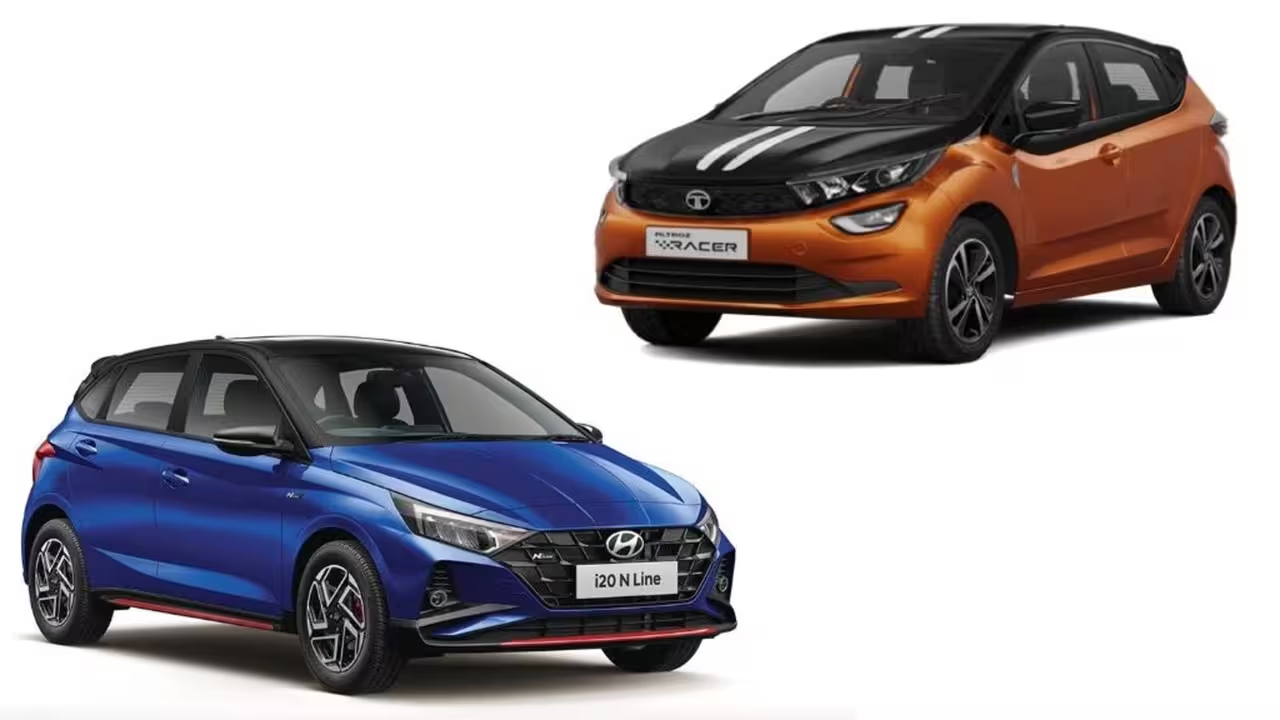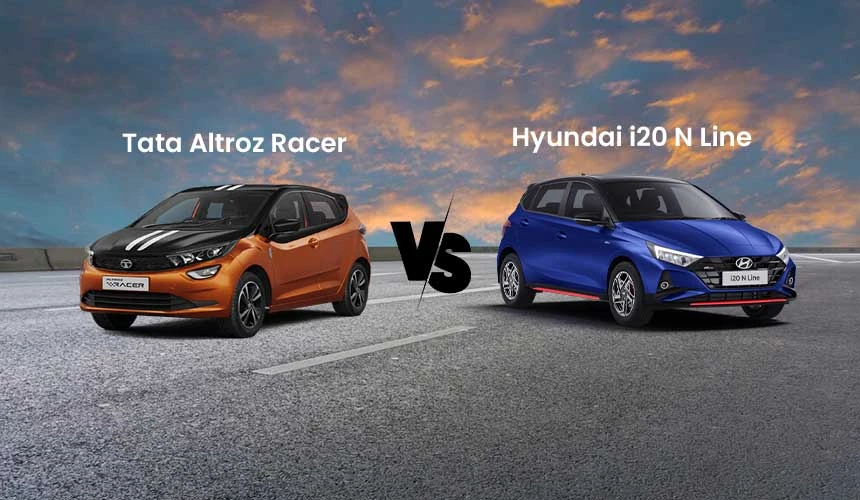Hyundai and Tata Motors deserve some credit. These two remain to wager on the hatchback market with two respectable offerings while other manufacturers are avoiding it, particularly the performance-oriented varieties. The Hyundai i20 N Line has long been the go-to option for those seeking a sporty hatchback, and for good reason. But then Tata decided to give the Altroz Racer another shot in this market, following the success of the Tiago JTP. To help you decide, we've put the two side by side and compared them.
Exterior Comparison: Tata Altroz Racer vs. Hyundai i20 N Line
Those two look the part, and it's clear that both brands worked hard to set their athletic avatars out from the rest. The Altroz already had a good look, but Tata gave it a more athletic attitude by blacking off the bonnet, roof, mirrors, wheels, and rear spoiler. Racing stripes along the center and Racer badging complete the Racer design.
On the other hand, the i20 N Line is more understated about its sporting intentions. A blacked-out front grille featuring the N Line insignia, sharper bumpers, dual muffler tips, distinctive 16-inch wheels, and red accents are some of the changes made compared to the basic i20. The choice between the bold Altroz Racer and the understated i20 N Line boils down to personal preference, as appearances are inherently subjective.
Read also: Electric Cars Vs Hybrid Cars
Interiors of the Hyundai i20 N Line vs the Tata Altroz Racer

Even inside, the athletic aim of both hatchbacks is evident. Racer interior details include an all-black color scheme, orange accent lighting, orange stitching on seats and steering, and 'Racer' embroidered on the headrests, elevating it above the ordinary Altroz. The plain-looking gear lever is disappointing, particularly in comparison to the N Line's. Although the front seats are comfortable and supportive, drivers who are particularly tall may find the lack of headroom caused by the sunroof to be an issue. There is almost as much room in the back as there is in the i20, and unlike the Hyundai, this one comes with an armrest that has cupholders. The Racer lacks load sensors for the seatbelt warning system, so fasten your belts even if nobody is in the car; otherwise, it will start blaring for a few seconds before every trip.
The i20 N Line is characterized by its trademark red color, much like the Altroz, which features orange highlights and decorations inside. Again, it's dressed in all black with dash highlights in red, ambient lighting in red, seat N logos in red, and red stitching on the seats and steering. Dashboard plastics are harsh and lack substance; nonetheless, the gear lever and steering wheel are luxurious, and you'll use them frequently in this vehicle. Both the gear lever and the steering wheel, which are designed specifically for the N, have an upscale appearance and feel. Sporty metal pedals are also available on the N Line.
How does the Hyundai i20 N Line compare to the Tata Altroz Racer
The only thing that these hot hatches have in common is that they are powered by three-cylinder turbo-petrol engines that produce 120 horsepower. Despite using indirect injection, the Tata's larger 1.2-liter displacement is less advanced than Hyundai's smaller 1.0-liter engine, which employs direct injection.
An earlier version of the Racer's engine, the Altroz iTurbo, debuted with 110 horsepower, 140 Newton-meters of torque, and a 5-speed manual transmission; at the time, space limitations prevented the inclusion of a 6-speed box, which could have handled the increased power. The problem has been resolved by Tata's engineering team, and the Racer now receives the same 120hp, 170Nm, and 6-speed manual tuning as the Nexon. The Racer, on the other hand, features shorter gear ratios and revised power delivery. The default option is "Sport," and there are no other driving modes available, in contrast to the Nexon.
Compared to the N Line, this engine is more linear in its power delivery, has a silkier ride, and is quick to react to throttle commands. In contrast, the N Line unit has a more powerful middle and pulls cleanly all the way to its 6,500 rpm redline thanks to its rev-happy nature. The cabin could have used a little more boom from the Hyundai engine, which is even more refined and has a pleasant raspy exhaust tone. The N Line manual shares the Racer in that it only has one driving mode: Sport.
How does the Hyundai i20 N Line handle and ride compared to the Tata Altroz Racer
The Altroz Racer makes up for lost ground in the area of ride and handling. Minor adjustments to the steering ratio and suspension spring rate elevate the already excellent ride and handling of the standard Altroz to a whole new level in the Racer. At any speed, the Racer handles damaged roads with the maturity of an experienced driver, giving the driver a wonderful sense of assurance. Actually, among modern mass-market hatchbacks, its suspension system is among the finest. Thanks to its precise steering and sturdy build, as well as its sharp front end, it can change directions with ease. Additionally, mechanical grip is good; yet, the premature tire failure was a little disappointment.
How much is the Hyundai i20 N Line vs. Tata Altroz Racer
Both the Altroz Racer R3 and the i20 N Line N8 MT are priced at Rs 10.99 lakh and Rs 11.27 lakh, respectively, ex-showroom, according to the tests. They each acquire some characteristics that are exclusive to themselves, and that's about it. Both are functional, roomy, and feature-packed, so they're sure to be popular with families and sports car fans.









